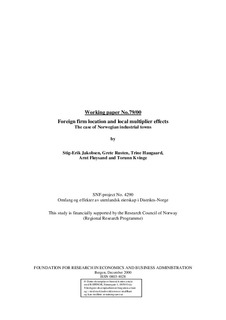| dc.description.abstract | The Foreign Direct Investment (FDI) theory show that these investments form regional effects. Our paper emphasis the heterogeneity of these effects. Different motives for FDI creates different multiplier effects, such as jobs, increased local production and new firms. Our study focus on two different industrial towns in Norway, where natural resources have attracted the foreign firms in the first town, while access to intangible technology resources has been the main attraction in the second. We compare differences and similarities in the way these investments have influenced local linkages and local growth processes. Here we draw on the theoretical contribution from the management model as well as the network model. Our findings indicates that foreign ownership per se do not explain multiplier effects. The motives, the sector-specific characteristics and the history of the local production system provide more reasonable explanations. | en |
